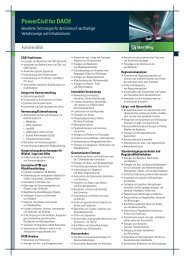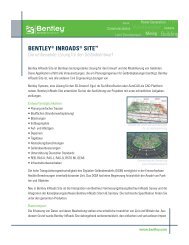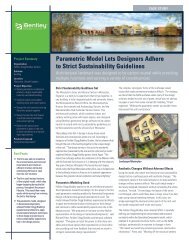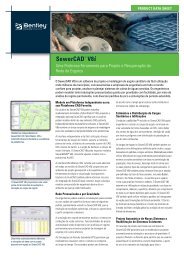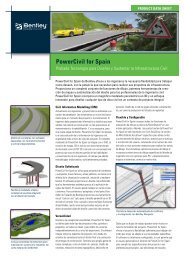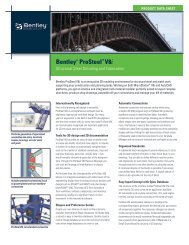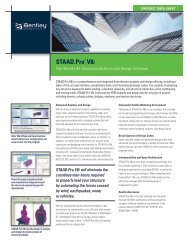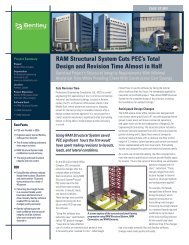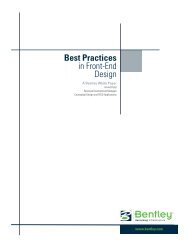The Future of Civil Engineering: Design for the ... - FTP - Bentley
The Future of Civil Engineering: Design for the ... - FTP - Bentley
The Future of Civil Engineering: Design for the ... - FTP - Bentley
You also want an ePaper? Increase the reach of your titles
YUMPU automatically turns print PDFs into web optimized ePapers that Google loves.
approach. “We started to see it with land development engineers as a way to better coordinate <strong>the</strong> architect and o<strong>the</strong>r<br />
disciplines on a project. But what we’ve seen lately is this idea that BIM is extending into road and highway projects where<br />
you’re able to build a very rich model and use it <strong>for</strong> things like driving visualization, simulation, analysis, and quantity take<br />
<strong>of</strong>f.”<br />
In <strong>the</strong> case <strong>of</strong> bridge design, Bhide said he’s seen <strong>the</strong> bridge industry change in <strong>the</strong> last five years to include more BrIM:<br />
“Demand <strong>for</strong> improved modeling, true-to-life details, constructability, and better integration <strong>of</strong> <strong>the</strong> real-time data<br />
between <strong>the</strong> multiple disciplines involved in a bridge project has been steadily increasing <strong>for</strong> a number <strong>of</strong> reasons:<br />
1. reduced construction costs with economical designs<br />
2. improved quantity take-<strong>of</strong>fs<br />
3. realistic visualization <strong>for</strong> selling <strong>the</strong> project<br />
4. virtual drive-thru.”<br />
As Bhide explained, <strong>Bentley</strong>’s BrIM approach that <strong>the</strong>y developed was in response to more <strong>of</strong> <strong>the</strong> industry needing to<br />
provide a virtual data model <strong>for</strong> all <strong>of</strong> <strong>the</strong> bridge lifecycle.<br />
Ano<strong>the</strong>r reason why model-based design is being used more <strong>of</strong>ten is because <strong>of</strong> government organizations like <strong>the</strong> GSA<br />
and U.S. Army Corps <strong>of</strong> Engineers mandating <strong>the</strong> process <strong>of</strong> <strong>the</strong>ir projects. With government support, o<strong>the</strong>rs are following<br />
suit, like transportation agencies. In addition, in one example, “<strong>the</strong>re’s a large land owner in Texas that mandated BIM not<br />
only <strong>for</strong> building projects but <strong>for</strong> any associated land development projects,” said Strafaci.<br />
While model-based design is a newer process that is catching on in <strong>the</strong> civil engineering industry, sustainability and green<br />
engineering is not. With sustainable design and construction getting so much attention <strong>the</strong>se days, it’s interesting to<br />
examine where civil engineering stands with this green uptake.<br />
Strafaci said sustainable design is definitely prevalent in <strong>the</strong> civil realm, but it’s nothing new because it’s something <strong>the</strong><br />
civil engineer has been doing <strong>for</strong> a long time – <strong>the</strong> only difference is now it is labeled as sustainable design. “So <strong>for</strong><br />
example, <strong>the</strong>re are requirements around a land development project or a transportation project. <strong>The</strong> civil engineer does<br />
an analysis be<strong>for</strong>e <strong>the</strong> development to figure out how much stormwater run-<strong>of</strong>f is going to come <strong>of</strong>f that site. And <strong>the</strong>n<br />
<strong>the</strong>y need to demonstrate that as a result <strong>of</strong> <strong>the</strong> development, <strong>the</strong>y’re not increasing <strong>the</strong> amount <strong>of</strong> run-<strong>of</strong>f coming <strong>of</strong>f<br />
and <strong>the</strong>y’re not negatively impacting <strong>the</strong> water quality,” explained Strafaci.<br />
In <strong>the</strong> simplest <strong>for</strong>m <strong>of</strong> sustainability every project could be more or less green, just depending on how much energy,<br />
water and materials are used <strong>for</strong> <strong>the</strong> design, construction and operation. Bhide explained <strong>the</strong>re has been a “renewed<br />
awareness” in <strong>the</strong> choices made to need to build bridges more efficiently and less expensively, and that sustainability is<br />
being sewn into projects to help meet <strong>the</strong>se needs while not compromising <strong>the</strong> resources <strong>of</strong> future generations.<br />
“Increased consumption <strong>of</strong> recoverable industrial wastes and byproducts in bridges, accelerated bridge construction, and<br />
design using high per<strong>for</strong>mance materials <strong>for</strong> long service lives <strong>of</strong> 75 or 100 years are a few sustainable strategies that are<br />
becoming very popular,” said Bhide.<br />
2 | P a g e



